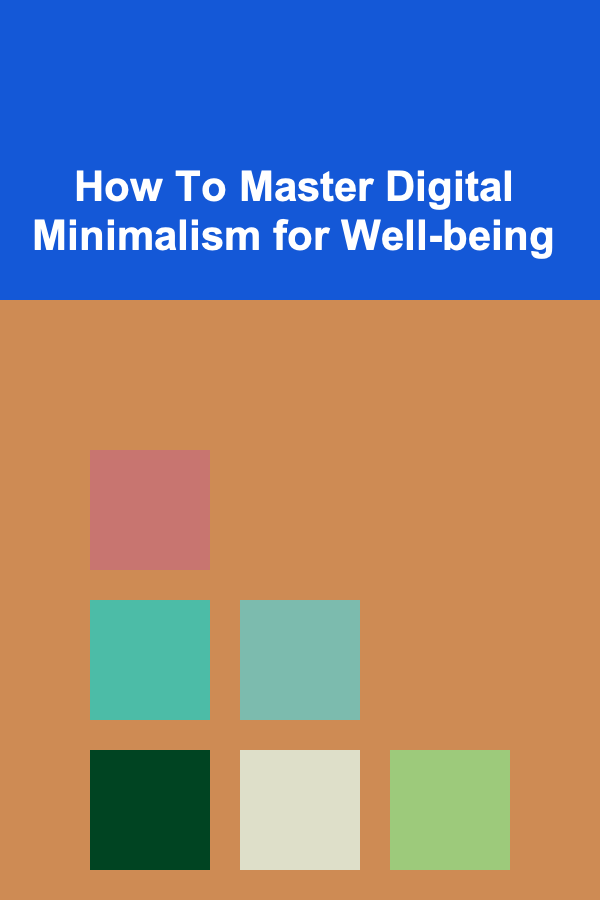
How To Master Digital Minimalism for Well-being
ebook include PDF & Audio bundle (Micro Guide)
$12.99$7.99
Limited Time Offer! Order within the next:

In an age where our lives are intertwined with technology, the concept of digital minimalism has emerged as a powerful antidote to the overwhelming nature of modern digital life. With the constant flow of notifications, endless scrolling, and digital distractions, many people find themselves disconnected from what truly matters. Digital minimalism offers a way to regain control over our relationship with technology, enabling us to lead more intentional, focused, and fulfilling lives. This article will explore the principles of digital minimalism, why it matters, and how to master it to enhance your well-being.
What Is Digital Minimalism?
Digital minimalism is the intentional practice of using technology in a way that aligns with your values and enhances your well-being, while minimizing unnecessary distractions and digital clutter. It's about being mindful of the technology you use, how you use it, and, importantly, why you use it.
The philosophy of digital minimalism is rooted in the idea that technology, while useful, should not control our lives. Instead, we should control how we engage with it. By cutting out the excess and focusing only on the tools that truly add value to our lives, we can free up time, reduce stress, and improve our mental health.
The Benefits of Digital Minimalism
Adopting digital minimalism can have profound effects on your life. Some of the key benefits include:
- Reduced Stress: Constant notifications, emails, and updates can create a sense of urgency and anxiety. By reducing digital clutter, you can experience a sense of calm and control.
- Improved Focus and Productivity: When we eliminate distractions, we can focus more deeply on the tasks that matter. This leads to greater productivity and a sense of accomplishment.
- Enhanced Mental Well-being: Excessive screen time, particularly on social media, can contribute to feelings of loneliness, anxiety, and depression. Digital minimalism helps to break free from the negative effects of constant digital consumption.
- Better Relationships: Reducing time spent on digital devices allows for more meaningful, face-to-face interactions with family, friends, and colleagues. This can strengthen relationships and improve your sense of community.
- Increased Free Time: By spending less time on digital devices, you create space for other activities that contribute to your well-being, such as exercise, hobbies, or spending time outdoors.
The Philosophy Behind Digital Minimalism
Digital minimalism is not just about reducing your screen time or decluttering your devices. It's a philosophy that encourages intentional living and values time, focus, and mental clarity. At its core, digital minimalism is about aligning your digital habits with your personal values and goals.
The concept was popularized by author and computer science professor Cal Newport in his book Digital Minimalism: Choosing a Focused Life in a Noisy World. Newport's approach is built on three main principles:
- Clutter is costly: Excessive digital consumption leads to cognitive overload and mental fatigue, making it harder to focus and be productive. By eliminating unnecessary digital distractions, we can reduce mental clutter and gain clarity.
- Optimization is important: Rather than using technology in a haphazard or scattered way, digital minimalism encourages you to carefully select tools and platforms that serve a specific purpose and align with your values.
- Intentionality is key: Digital minimalism emphasizes the importance of using technology with intention. Rather than reacting to notifications or falling into passive consumption, it encourages you to actively choose how and when to engage with digital tools.
How to Master Digital Minimalism for Well-being
Mastering digital minimalism involves more than just cutting back on screen time. It's about cultivating a mindful and intentional approach to your digital life. Here are some practical steps you can take to embrace digital minimalism and improve your well-being:
1. Identify Your Digital Priorities
The first step in mastering digital minimalism is identifying your priorities. What are the things that matter most to you? These are the activities, relationships, or goals that you value the most and want to focus on.
Take some time to reflect on your current digital habits. Which apps, websites, and platforms contribute to your well-being and personal growth? Which ones drain your energy, time, and attention without offering much in return? Make a list of your digital priorities, and use it as a guide to streamline your digital life.
2. Declutter Your Digital Space
One of the most effective ways to practice digital minimalism is by decluttering your devices. This means removing unnecessary apps, emails, files, and notifications that only serve to distract and overwhelm you. Start by taking a close look at your phone, computer, and other devices, and ask yourself whether each item adds value to your life.
- Unsubscribe from email lists: Unsubscribe from promotional emails or newsletters that you never read. This will reduce inbox clutter and prevent unnecessary distractions.
- Delete unused apps: Remove apps that you rarely use or those that cause you to waste time mindlessly scrolling. Keep only the ones that are essential to your daily life or contribute to your personal growth.
- Organize your digital files: Organize your documents, photos, and other digital files in a way that makes it easy to find what you need. This will reduce the mental load of having to search through cluttered files.
3. Set Boundaries Around Screen Time
In the digital age, it's easy to get lost in endless scrolling, checking emails, or binge-watching TV shows. To embrace digital minimalism, it's essential to set clear boundaries around your screen time. Here are some strategies to help you do that:
- Create a daily screen time limit: Set a specific amount of time each day for digital activities, whether it's social media, watching videos, or checking email. Use screen time trackers to monitor your usage and hold yourself accountable.
- Designate tech-free zones: Create tech-free spaces in your home, such as the bedroom or dining table, to encourage mindfulness and better sleep hygiene. This will help you disconnect and recharge.
- Schedule digital detoxes: Dedicate certain days or weekends to unplugging completely from digital devices. Use this time to focus on offline activities like reading, exercising, or spending quality time with loved ones.
4. Prioritize Face-to-Face Interactions
While digital communication has its place, face-to-face interactions are crucial for maintaining meaningful relationships and improving well-being. Digital minimalism encourages you to prioritize real-life connections over virtual ones. Here are some ways to do that:
- Limit social media use: Social media can be a major source of distraction and comparison. If you feel overwhelmed or disconnected, consider reducing your time on social platforms or removing them altogether.
- Make time for in-person meetings: Schedule regular meetups with friends, family, or colleagues. Even a short coffee date or walk can strengthen relationships and boost your mood.
- Engage in offline hobbies: Take up activities that don't require screens, such as reading, painting, cooking, or playing a musical instrument. These activities help reduce stress and foster creativity.
5. Use Technology with Intention
Digital minimalism isn't about rejecting technology altogether. It's about using it in a way that serves your goals and enhances your well-being. Here's how you can use technology with intention:
- Choose tools that add value: Instead of using multiple apps for similar purposes, select the tools that serve you best. For example, use one calendar app to manage your schedule, one task manager to keep track of your to-do list, and one social platform for staying connected with loved ones.
- Set specific goals for technology use: When you engage with technology, do so with a clear intention. For example, set a goal to read a specific number of articles or watch educational videos that align with your personal growth.
- Avoid mindless consumption: Avoid falling into the trap of endless scrolling, checking notifications, or passively consuming content. Instead, set limits on your usage and engage with content that enriches your life.
6. Adopt a Healthy Digital Mindset
Finally, mastering digital minimalism is about cultivating a healthy mindset toward technology. This involves recognizing that technology is a tool, not a master. Here are some tips for developing a healthier digital mindset:
- Practice digital mindfulness: Pay attention to how you feel when using digital devices. Notice if you're feeling anxious, distracted, or overwhelmed, and take breaks when necessary. Practice mindfulness techniques like deep breathing or meditation to regain focus and clarity.
- Embrace boredom: In a world filled with constant stimulation, it's easy to fear boredom. However, embracing moments of stillness and discomfort can lead to creativity, reflection, and personal growth. Allow yourself time to be unplugged and free from digital distractions.
- Focus on what matters: Remind yourself regularly of your values, priorities, and goals. Use technology as a tool to support these rather than allowing it to consume your time and attention.
Conclusion
Mastering digital minimalism is a powerful way to reclaim your time, focus, and well-being in an increasingly digital world. By adopting a minimalist approach to technology, you can reduce stress, improve your productivity, and cultivate more meaningful relationships and experiences. The key to digital minimalism is intentionality---choosing the digital tools that serve your life, setting boundaries around your screen time, and prioritizing face-to-face interactions. Ultimately, digital minimalism is about using technology to enhance your life, not control it.

How to Create a Productive Workflow for Editing Academic Papers
Read More
How to Create a Relaxing Bedroom Ambiance with Lighting
Read More
How to Use Foam Panels for Sound Absorption
Read More
How to Use Under-Bed Storage for Seasonal Items
Read More
How to Understand the Philosophy of Economics
Read More
How to Pack a Carry-On for a Week-Long Hiking Trip
Read MoreOther Products

How to Create a Productive Workflow for Editing Academic Papers
Read More
How to Create a Relaxing Bedroom Ambiance with Lighting
Read More
How to Use Foam Panels for Sound Absorption
Read More
How to Use Under-Bed Storage for Seasonal Items
Read More
How to Understand the Philosophy of Economics
Read More